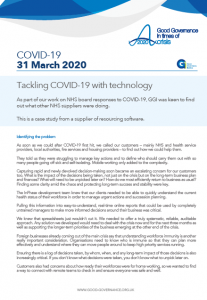Tackling COVID-19 with technology
31 March 2020

As part of our work on NHS board responses to COVID-19, GGI was keen to find out what other NHS suppliers were doing. This is a case study from a supplier of resourcing software.
Identifying the problem
As soon as we could after COVID-19 first hit, we called our customers – mainly NHS and health service providers, local authorities, fire services and housing providers – to find out how we could help them.
They told us they were struggling to manage key actions and to define who should carry them out with so many people going off sick and self-isolating. Mobile working only added to the complexity.
Capturing rapid and newly devolved decision-making soon became an escalating concern for our customers too. What is the impact of the decisions being taken, not just on the crisis but on the long-term business plan and finances? What will need to be unpicked later on? How do we most efficiently return to business as usual? Finding some clarity amid the chaos and protecting long-term success and stability were key.
The InPhase development team knew that our clients needed to be able to quickly understand the current health status of their workforce in order to manage urgent actions and succession planning.
Pulling this information into easy-to-understand, real-time online reports that could be used by completely untrained managers to make more informed decisions around their business was critical.
We knew that spreadsheets just wouldn’t cut it. We needed to offer a truly systematic, reliable, auditable approach. Any solution we developed would need to deal with the crisis now and for the next three months as well as supporting the longer-term priorities of the business emerging at the other end of the crisis.
Foreign businesses already coming out of the main crisis say that understanding workforce immunity is another really important consideration. Organisations need to know who is immune so that they can plan more effectively and understand where they can move people around to keep high priority services running.
Ensuring there is a log of decisions taken, by whom, when, and any long-term impact of those decisions is also increasingly critical. If you don’t know what decisions were taken, you don’t know what to unpick later on.
Customers also had concerns about how ready their workforces were for home working, so we wanted to find a way to connect with remote teams to check in and ensure everyone was safe and well.
The COVID-19 app
The InPhase team came up with the COVID-19 app, with the concept of the daily check-in at its heart. It’s a process that each employee can carry out within five seconds – and it helps our customers demonstrate that all-important human touch.
The daily check-in feeds managers’ action and decision management reports and dashboards. It helps our clients prioritise and succession plan and automatically distribute critical actions. Action updates are tracked and reported real-time. Decision taken by the teams are also tracked.
What have we seen since people started to use our new COVID-19 app? A more engaged workforce, better real-time reporting around who is working and how and where they are, which is enabling managers to get a better grip on keeping services running.
We have seen customers benefiting from centralising all crisis actions into the COVID-19 app, helping them to begin to move out of fire-fighting and into a more structured action and decision management approach.
Key business benefits
- Improved workforce management
The app massively improves your real-time understanding of what is happening with your workforce, helping you understand where there are capacity issues in the workforce so team members can be redeployed to where they are needed the most.
The trend and exposure risk information enables managers to foresee where capacity is most likely to fail in the next seven days and act before problems arise.
The immunity information enables services to be strengthened with more resilience where it matters most.
- Effective action planning and responsiveness
The centralised database of COVID-19 actions means you don’t duplicate effort, lose track of critical actions or miss a key issue because everyone thought someone else was dealing with it.
Instant escalation means managers know in real-time that staff don’t know what to do so they can step in before things get out of control.
Triggered action transfer means critical actions don’t stall for days when the number of staff unable to work rises rapidly.
- Up and running within 24hrs
The system has been pre-built on a robust and proven InPhase application and Microsoft technology platform so you can start making use of the solution when you need it most – right now.
That means there’s no need to take teams away from the important work they’re already doing to build a complex IT platform and you can access it from anywhere.
GGI would like to thank Robert Hobbs, CEO of InPhase, for this contribution. You can find out more about InPhase at https://www.inphase.com.
GGI shares this case study as part of our work to highlight learning. GGI has no commercial connection to InPhase and has received no funding from the company. We just thinking it’s an interesting example of how NHS suppliers are stepping up to help their clients.

